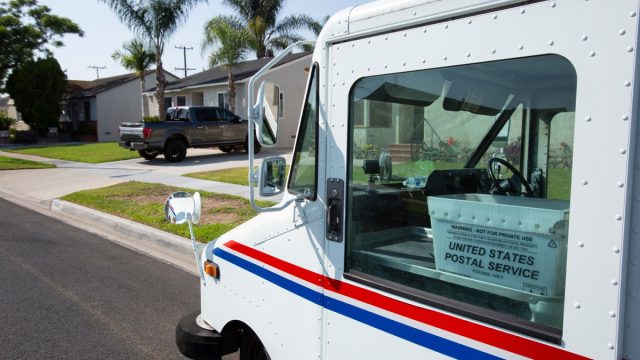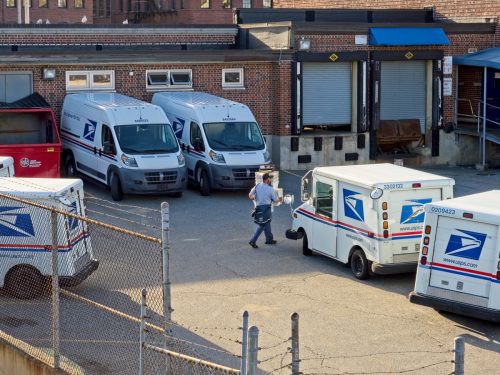USPS Will Make These Mail Changes "Rapidly," Postmaster General Says
The agency is focusing in on one specific initiative to fix the Postal Service.

When Louis DeJoy took over the U.S. Postal Service (USPS) in 2020, he assumed the role of postmaster general with a major overhaul on his mind. In March 2021, he unveiled his Delivering for America (DFA) initiative, a 10-year plan meant to help the agency eventually "achieve financial sustainability and service excellence," according to the USPS. Since then, customers have been inundated with regular changes as part of this transformation—from price hikes to slower delivery service. In his latest update on DFA, DeJoy has shared more about what to expect going forward. Read on to find out about the changes he says are "rapidly" coming to the USPS.
READ THIS NEXT: USPS Is Asking for These Changes to Your Mailbox, Starting This Week.
The USPS reports that it's already made progress under its current plan.

It's been two years since the Postal Service first unveiled the plans for its decade-long overhaul, and there has already been significant progress, according to the agency.
On April 27, the USPS released its Second-Year Progress Report on the DFA initiative. The report detailed many of the achievements the agency has made and the milestones it's reached during this time, including improving service performance for customers and converting 125,000 employees to full-time positions.
"As we enter the third year of our Delivering for America plan, there is a new energy and vibrancy at the U.S. Postal Service," DeJoy said in a statement. "As I travel the nation meeting with the great men and women of the Postal Service, it is clear the investments we are making are paying off—and it is showing through our improved delivery for the American people and our business customers. The progress we've made in the last two years demonstrates that our plan is realistic and achievable. We're just getting started."
But DeJoy says the agency needs to focus on making certain mail changes "rapidly."

Despite the "strong progress" that has been made under the DFA plan so far, there is still a lot of work left to be done. During the 2023 National Postal Forum in Charlotte on May 22, DeJoy highlighted what the Postal Service needs to focus on now during his keynote address: modernizing the postal network.
"The biggest initiative, and one that will address a condition that has driven high costs and restricted performance, is the redesign of our national processing network and the operating practices we deploy to use it," the postmaster general said.
The USPS has already committed nearly $7.6 billion of the plan's $40 billion self-funded investment budget to put its modernization plans in motion, according to a press release. But in the third year of its DFA initiative, the agency will get more aggressive in tackling its goal of creating a modernized postal network.
"We must now execute rapidly on our plans to deploy our network," DeJoy said during his address. "This is the only way to achieve the service and cost improvements necessary for us to fulfill our mission to rescue this organization."
RELATED: For more up-to-date information, sign up for our daily newsletter.
This centers around the formation of new processing and distribution centers.

The Postal Service's modernization plans involve a number changes. But one of the key elements of this strategy is the formation of new facilities. According to the press release, the USPS plans to establish a total of 60 Regional Processing and Distribution Centers (RPDCs) as part of its DFA initiative.
"We have launched a new, flexible construction program to create a modern, streamlined and effective network of new or reimagined, clean, spacious and bright processing facilities," the agency explained in the April 27 press release.
So far, the USPS has just gotten design work underway for 11 new RPDCs. These centers will be located in Atlanta; Richmond, Virginia; North Houston, Texas; Greensboro, North Carolina; Santa Clarita, California; Portland, Oregon; Charlotte, North Carolina; Chicago; Indianapolis; Jacksonville, Florida; and Boise, Idaho
The Atlanta, Richmond, Charlotte, and Chicago RPDCs will be opened sometime in 2023, with the others and more locations expected to open "in the coming years," per the agency.
Customers will see changes in their deliveries as a result.

The creation of these centers might seem unimportant to the average customer—but it's not. As the USPS explains, these new RPDCs will allow the agency to "simplify the movement of all classes of mail and packages."
In other words, the Postal Service is trying to streamline and speed up its deliveries with the formation of these regional facilities. The USPS says these new facilities will bring about several operational changes, all with the goal of strengthening the agency and improving service for customers.
"We are going to deploy package sorting equipment with significantly more capacity and sophistication, giving us the ability to execute on strategies to increase throughput and reduce cost. And this will benefit both mail and package flow," DeJoy explained during his keynote address. "Once completed, this new network will be able to accept mail and packages at specified cutoff times and reach millions of delivery points the next day, taking the Postal Service from the leader in the last mile to the leader in the last 150 miles."
The postmaster general added, "I believe we can become the preferred delivery provider in the nation, reclaiming volume we have lost over the years and capturing a significant portion of the future growth in the marketplace."
- Source: https://about.usps.com/what/strategic-plans/delivering-for-america/
- Source: https://about.usps.com/what/strategic-plans/delivering-for-america/assets/usps-dfa-two-year-report.pdf
- Source: https://about.usps.com/newsroom/national-releases/2023/0427-usps-improving-service-reliability-in-first-two-years-of-dfa.htm
- Source: https://about.usps.com/newsroom/national-releases/2023/0522-pmg-louis-dejoy-extols-significant-organizational-progress-in-2023-npf-keynote-address.htm





















